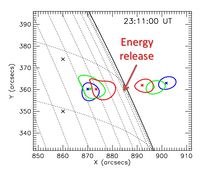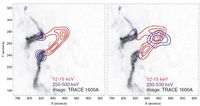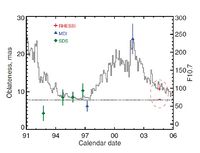RHESSI's Tenth Anniversary
From RHESSI Wiki
m (→Solar Oblateness) |
m (→Magnetar timing and spectroscopy) |
||
| Line 89: | Line 89: | ||
===Magnetar timing and spectroscopy=== | ===Magnetar timing and spectroscopy=== | ||
| - | RHESSI | + | [[Image:Hurleyetal_1_2005.jpg|200px|thumb|left|'''Figure''': RHESSI 20 - 100 keV light curves of the giant magnetar flare]] |
| + | [[Image:Hurleyetal2005.jpg|200px|thumb|right|'''Figure''': RHESSI 20 - 100 keV light curves of the tail phase of the flare.]] | ||
| - | + | RHESSI serendipitously detected a huge flare from the soft-gamma-ray repeater (SGR) 1806–20 that was just 5.25° from the Sun at the time of the observations. SGRs are thought to be magnetar - isolated, strongly magnetized neutron stars with teragauss exterior magnetic fields and even stronger fields within, making them the most strongly-magnetized objects in the Universe. In the first 0.2 s, the flare released as much energy as the Sun radiates in a quarter of a million years. This observation suggested that a significant fraction of the mysterious short-duration gamma-ray bursts may come from similar extragalactic magnetars. | |
| - | + | ||
| - | + | ||
| - | + | ||
Hurley et al. (2005) | Hurley et al. (2005) | ||
| - | An exceptionally bright flare from SGR 1806−20 and the origins of short-duration gamma-ray bursts | + | An exceptionally bright flare from SGR 1806−20 and the origins of short-duration gamma-ray bursts, Hurley et al., Nature, 434, 1098 (2005). |
| - | + | ||
| - | Hurley et al., Nature, 434, 1098 (2005). | + | |
===Transient Gamma-ray Flashes (TGFs)=== | ===Transient Gamma-ray Flashes (TGFs)=== | ||
Smith et al. (200?) | Smith et al. (200?) | ||
Revision as of 14:59, 31 January 2012
RHESSI's Scientific Legacy
February 5, 2012, marks the 10the anniversary of RHESSI's launch. At this time, it seems appropriate to review the scientific achievements to date, and here I offer a personal top-ten list of the iconic figures that I think will constitute RHESSI's legacy. A much more comprehensive review of RHESSI's scientific achievements can be found in the recently published Space Science Review (Vol. 159, Issue 1-4) - High-Energy Aspects of Solar Flares: A RHESSI-inspired monograph.
First of all, it is important to remember that RHESSI was designed to combine both X-ray and gamma-ray imaging spectroscopy in a single instrument with the stated goal of investigating particle acceleration and energy release in solar flares. It is natural to breakdown the scientific results relating to this goal into three areas - those relating to the nonthermal electrons that produce the harder X-ray and gamma-ray continuum emissions, those relating to the energetic ions that produce gamma-ray emissions, and those relating to the hot thermal plasma that produces the softer X-ray emission in the lower end of RHESSI's energy coverage down to ~3 keV. I will consider results in these three areas as they reflect the importance in establishing RHESSI's unique contributions to understanding flare energy release and particle acceleration. In addition, this list would be incomplete without acknowledging the importance of RHESSI's serendipitous contributions to other aspects of solar physics, to astrophysics, and to Earth sciences.
Double Coronal X-ray Sources
The detection of twin X-ray sources in the solar corona with opposite spectral evolution as a function of altitude. This provided the strongest evidence yet for energy release in the corona between the two sources as indicated in Fig. 1.
Sui and Holman, 2003, Evidence for the Formation of a Large-Scale Current Sheet in a Solar Flare, ApJ, 596, L251-L254.
Initial downward motion of X-ray sources
Sui and Holman (2003) also reported the initial downward motion of the coronal X-ray source prior to the previously reported continuous upward motion. This was further detailed by Sui et al. (Sui, Holman, & Dennis 2004, Ap. J., 612, 546), where it was shown (Fig. 2) that the rate of altitude increase correlated with the hard X-ray flux suggesting that it was related to the energy release rate.'
Location of superhot X-ray source
The location of a superhot X-ray source in the corona and a second cooler thermal source at lower altitudes.
Caspi and Lin (2009?)
Coincidence of flare impulsive phase with CME acceleration
Temmer et al. (200?)
Photosphere as a dentist's mirror
Kontar et al. (200?)
Coronal hard X-rays sources
The observations reflect non-thermal emissions from electrons over a wide range of energies (few keV for double coronal sources, and into the MeV range for the coronal gamma-ray sources. There are clear hints that the coronal hard X-ray sources may have different physics (for example, acceleration mechanisms) in some cases but there is still no real understanding of how they are generated.
Krucker et al.(2008) Krucker S, Hurford GJ,MacKinnon AL, Shih AY, Lin RP, 2008) "Coronal gamma-ray bremsstrahlung from solar flare-accelerated electrons," ApJL 678:L63–L66, doi:10.1086/588381
Multiple footpoint X-ray sources
The detection of multiple footpoint hard X-ray sources and their propagation along flare ribbons.
Fletcher et al. (2007?)
Different X-ray and gamma-ray source locations
The detection of gamma-ray sources at locations different from the locations of X-ray sources. This is shown here for the flare on 2003 Oct. 28, where the contours of the gamma-ray and hard X-ray sources are overlaid on a TRACE 195 Angstrom image taken in the same time frame. The implications of this surprising result are still not clear but it implies spatial differences in the acceleration and/or transport of energetic electrons and ions.
Hurford, G. J., Schwartz, R. A., Krucker, S., Lin, R. P., Smith, D. M., & Vilmer, N. 2003, "First Gamma-Ray Images of a Solar Flare," ApJ, 595, L77.
Hurford et al. 2006, "Gamma-Ray Imaging of the 2003 October/November Solar Flares," ApJ, 644: L93–L96.
Broadened 511-keV positron annihilation line
Measurement of a surprisingly broad 511-keV positron annihilation line indicating that the temperature of the ion interaction region was above 105, K. Later, in some flares, the width of the line narrows to ∼1 keV consistent with annihilation in ionized H at < 104K and ≥1015 cm-3. The full implications of these observations are still unclear but they bring into question the energy source of the heating and if the ions alone can produce such a highly dynamic flaring atmosphere at chromospheric densities that can reach transition-region temperatures, then cool to less than 104 K in minutes while remaining highly ionized.
Share et al. (2004) RHESSI e+ -- e- ANNIHILATION RADIATION OBSERVATIONS: IMPLICATIONS FOR CONDITIONS IN THE FLARING SOLAR CHROMOSPHERE Gerald H. Share, Ronald J. Murphy, David M. Smith, Richard A. Schwartz, and Robert P. Lin, ApJ, 615:L169–L172, 2004.
Solar Oblateness
Measurements of the solar diameter using RHESSI's Solar Aspect System showed unexpectedly large flattening compared to what is predicted from solar rotation. Fivian et al. (2008) were able to show that this effect was due to magnetic elements in the enhanced network producing emission preferentially at lower latitudes. Once this contribution was removed, the corrected oblateness of the nonmagnetic Sun was determined to be 8.01 +/- 0.14 milli–arc seconds, which is near the value expected from rotation of 7.8 milli–arc seconds, or ~0.001%. This result explained the variation that had been reported with solar cycle and is the most accurate measure of the true oblateness ever made.
Fivian et al. (2008) A Large Excess in Apparent Solar Oblateness Due to Surface Magnetism Martin D. Fivian, Hugh S. Hudson, Robert P. Lin, H. Jabran Zahid1
Magnetar timing and spectroscopy
RHESSI serendipitously detected a huge flare from the soft-gamma-ray repeater (SGR) 1806–20 that was just 5.25° from the Sun at the time of the observations. SGRs are thought to be magnetar - isolated, strongly magnetized neutron stars with teragauss exterior magnetic fields and even stronger fields within, making them the most strongly-magnetized objects in the Universe. In the first 0.2 s, the flare released as much energy as the Sun radiates in a quarter of a million years. This observation suggested that a significant fraction of the mysterious short-duration gamma-ray bursts may come from similar extragalactic magnetars.
Hurley et al. (2005)
An exceptionally bright flare from SGR 1806−20 and the origins of short-duration gamma-ray bursts, Hurley et al., Nature, 434, 1098 (2005).
Transient Gamma-ray Flashes (TGFs)
Smith et al. (200?)







